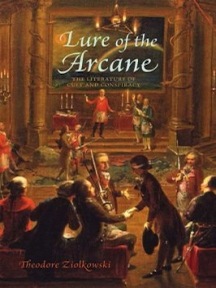By Benjamin Franklin Martin
For five decades through many books, Theodore Ziolkowski has pursued the ambiguities of western intellectual history from the ancient world to the present. In Lure of the Arcane, he examines the “conspiracy phenomenon,” which he facetiously dates from the account of Adam, Eve, and the Serpent. Following the loss of Paradise, contemporaries blamed the decline of Athenian democracy and then the Roman Empire on mystery cults, the Thirty Years’ War on the Rosicrucians, the French Revolution on the Freemasons, the revolutions of 1848 on Romantic Socialism, the collapse of traditional morality on Satanism, and the Russian Revolution and Great Depression on a Jewish plot for world domination. His approach is to analyze the “fiction of cults and conspiracies,” the expression of what he calls “a basic human impulse to enjoy secrets” and of the desire to “make sense of a world grown incomprehensibly chaotic.”
Ziolkowski begins with the quest for special communion and higher knowledge: the cults from Greece and Rome, Dionysus and Isis, portrayed, respectively, by Euripides in The Bacchae (406-05 BCE) and Apuleius in The Golden Ass (c. 160 BCE), then accounts of the medieval Knights Templar and the legend of the Holy Grail. He turns next to the fascination with secret societies and their presumed conspiracies, the Rosicrucians, the Freemasons, and the Illuminati, analyzing Wolfgang Amadeus Mozart’s The Magic Flute (1791), Friedrich Schiller’s The Ghost-Seer (1789), and Johann Wolfgang Goethe’s Wilhelm Meister’s Apprenticeship (1795-96).
For the early nineteenth century, Ziolkowski treats Romantic Socialism’s search for “an organically unified society motivated by pristine Christian values,” as described in George Sand’s The Countess of Rudolstadt (1843-44), Edward Bulwer-Lytton’s Zanoni (1842), and Eugène Sue’s The Wandering Jew (1844-45), which he calls the “direct predecessor of many conspiracy thrillers.” For the resurgence of the occult and magic that marked the end of the nineteenth century and the beginning of the twentieth, he chooses J.-K. Huysman’s The Damned (1891), André Gide’s The Vatican Cellars (1914), Thornton Wilder’s The Cabala (1926), and Hermann Hesse’s Demian (1919) and The Glass Bead Game (1943). Concurrently, the fear of conspiracy found perhaps its perfect illustration through an infamous fraud, the Protocols of the Elders of Zion, which appeared first in Russia (1903) and then spread in many languages after its transmission to western Europe by White Russian refugees after 1920.
Ziolkowski concludes with Umberto Eco’s Foucault’s Pendulum (1988), which he argues recapitulates in fictional form the history he has just recounted. He adds a warning that cults and conspiracies flourish in “periods of religious-intellectual, social-political disenchantment”—thus the explanation for such books and theories today.
Benjamin Franklin Martin (ΦΒΚ, Davidson College, 1969) is the Price Professor of History at Louisiana State University and a resident member of the Beta of Louisiana Chapter of Phi Beta Kappa.




